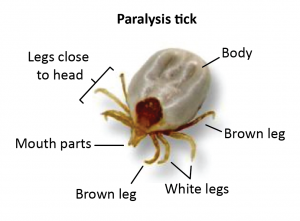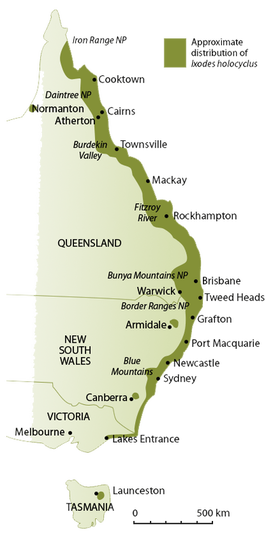
With spring right around the corner in Australia, pet owners should once again be on the lookout for paralysis ticks. It is also a good time to ensure the chew or spot-on protection you are choosing for your dog or cat will protect them against deadly tick paralysis. Worryingly, 82% of dog owners who live in regions where there are paralysis tick are not treating their pet correctly. However, 65% of pet owners living in paralysis tick areas think they are treating correctly. This ultimate guide to paralysis ticks will cover tick identification, locations, life stages, removal, symptoms, treatment and prevention.
What Does a Paralysis Tick Look Like?
The paralysis tick (lxodes holocyclus), also called the seed or grass tick, is a greenish-gray colour that can be as small as a pinhead and grow to be as large as a thumbnail. The longer the tick has been feeding on your pet, the larger it will be.
As the name suggests, paralysis ticks cause paralysis in humans, dogs, cats and other animals through the secretion of a paralyzing toxin that is excreted while they feed. This toxin causes a disruption between the nerves and the muscles in various parts of the body which leads to paralysis. Poisoning by paralysis tick toxin can be fatal if left untreated.
Image from Small Animal Specialist Hospital
Where Are Paralysis Ticks Found?
In Australia, the paralysis tick can be found all along the east coast of Australia from the northernmost part of Queensland right down to eastern parts of Victoria. Paralysis ticks live in bushy coastal areas as they prefer a warm, humid climate. Paralysis ticks are most prevalent in the warmer months between spring and autumn; however, in the warmer parts of Australia, such as in Queensland, paralysis tick season can be all year round.
Your pet can pick up a paralysis tick from venturing into areas where native wildlife such as bandicoots, echidnas and possums live, or from playing or rolling in piles of leaf litter. These native animals have adapted to life with ticks and constant exposure to the toxin means they are now immune to its paralysing effects.
Image from Eric Broad Veterinary Surgeon
Paralysis ticks go through 4 stages of life – starting out as an egg, maturing to a larva (about 0.5mm long), nymph (about 1mm long) and an adult (larger than 1mm long). Female adult ticks lay up to 3000 eggs in leaf litter every month and remain as eggs for 40-60 days before hatching into larvae.
There are over 70 species of tick found in Australia and unfortunately, colour isn’t always a useful indicator when attempting to identify species, as it can be changed by the tick feeding. Their legs are their best feature with which to distinguish a paralysis tick from other species. Paralysis ticks have one pair of brown legs closest to their head and another set closest to their body, and then two pairs of white legs in between. Typically, it is only female paralysis ticks that bite humans or animals. Female paralysis ticks have a longer mouthpart and their first and last sets of legs are different colours. Male paralysis ticks do not usually feed from humans or animals as they feed directly from the female paralysis tick.
Image from Northside Emergency Veterinary Service showing a Paralysis Tick, a Brown Dog Tick and a Bush Tick
How to Remove a Paralysis Tick From Your Cat or Dog
If you find a tick on your pet, keep calm and carefully remove the tick with a tick remover or pair of tweezers. If you suspect it is a paralysis tick, take your pet to your nearest veterinarian immediately as the toxin will continue to affect your pet even after you remove the tick. It only takes one adult paralysis tick to kill a dog, but many pets will have more than one tick on their body, so it is important that you don’t stop searching after you have removed one tick.
If you are not sure if it is a paralysis tick and your dog is not displaying any symptoms of paralysis, after you have removed the tick, store it in a sealed container just in case your pet does become unwell and it is needed for identification. When searching for ticks on your pet, don't stop after you have found one. It is likely that there are more ticks hiding on your pet.
To ensure you don’t miss any ticks when searching your pet, you should slowly and carefully run your fingers over every part of their coat, ensuring you apply enough pressure to be able to feel any lumps and bumps underneath that may indicate the presence of a tick. Remember to check inside your pets’ ears, under their neck, around their eyes, between their toes, around their anal area, and don’t forget to check their tail.
Symptoms of a Paralysis Tick Bite
If your pet has been bitten by a paralysis tick, it can take up to 5 days for them to display symptoms of paralysis. Once symptoms of paralysis appear however, your pet can deteriorate very rapidly.
Initial symptoms of paralysis tick poisoning in dogs and cats includes dilated pupils, weakness in the back legs (often the pet just sits down suddenly), a change in your pets’ meow or bark, and vomiting (especially if regular and froth is present). As the toxin spreads, your pet will start to suffer from increased wobbliness in their back legs, may begin panting or making loud breathing or grunting noises and may have a moist cough.
In the later stages of toxicity, your pet will become unable to stand at all, breathing becomes extremely difficult and exaggerated, your pet starts gagging, coughing or grunting more frequently, and as their breathing becomes more labored, their gums become cold and blue.
Treatment and Prevention of Tick Paralysis
Pets that begin treatment in the earlier stages of paralysis tick toxicity have a better chance of recovering fully and more quickly, so you should get your pet to your nearest veterinarian as quickly as possible if you suspect a paralysis tick bite. The veterinarian will administer an anti-serum to your pet that is designed to neutralise the toxin, but your pet will be required to stay at the vet for a number of days for observation and to ensure all of the ticks have been killed and removed.
But as we all know, prevention is better than cure, and there are a number of steps you can take as a pet owner to protect your pet against paralysis ticks.
Avoid Bushland and Check Your Pet Regularly
Avoiding areas where ticks can be found is one of the best ways of preventing paralysis ticks from attaching to your pet but this isn’t always easy to do. Therefore, you should also check your pet regularly for ticks, especially after walking in bushland where ticks might live.
If you live in an area surrounded by bushland, you might want to consider creating a barrier between the bushland and your yard by cutting down the vegetation or spreading a layer of mulch and woodchips a few meters wide to stop vegetation from growing too close and providing easy access to your yard for ticks.
Protect with Regular Prevention Application
There is no vaccination currently available that will protect your pet against paralysis ticks, but there are a number of products on the market that can both kill paralysis ticks on your pet and prevent them from attaching to your pet in the first place.
Tick preventative products are available as a collar and in both chewable and spot-on treatment forms and can last up to 6 months in some cases. Many products will also treat and prevent fleas, some worms and mites at the same time, but may require more frequent application to ensure coverage, so be sure to read the instructions carefully.











